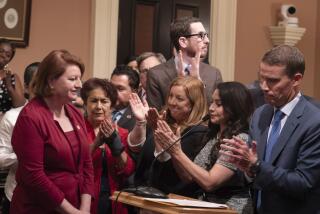‘The Pink Lady’ by Sally Denton
It is odd how history often bequeaths to us iconic names bereft of personality.
Helen Gahagan Douglas, once a paladin of California’s progressive politics and a congressional stalwart of Franklin Roosevelt’s New Deal, is such a name. To the extent she’s now remembered at all, it’s as the victim of Richard M. Nixon’s notoriously dirty 1950 campaign for one of the state’s U.S. Senate seats.
Sally Denton’s “The Pink Lady: The Many Lives of Helen Gahagan Douglas” does an admirable if sometimes needlessly breathless job of restoring flesh and sinew to a remarkable woman and political personality, who stands as a kind of archetype of today’s engaged Hollywood celebrity.
Douglas was born at the turn of the century and died in 1980. She was the New York-raised daughter of wealth and privilege who defied her domineering but loving father and gave up a promising academic career for a successful run as a Broadway actress and, later, as an opera singer in Europe. After the crash of 1929, she returned to the American stage and met and married American actor Melvyn Douglas.
As a staunch supporter of the New Deal, Gahagan Douglas became one of Eleanor Roosevelt’s intimates and was elected as California’s second female congressional representative. In Washington, she became not only a confidant to both Roosevelts but also the lover of an up-and-coming Democratic congressman from Texas named Lyndon Johnson.
In 1950, against all serious advice, Douglas decided to run for the U.S. Senate against a rising young GOP congressman with a ferocious taste for red-baiting. Nixon and his political mentor, Murray Chotiner, turned the campaign into a virtual compendium of dirty tricks, stirring up not only unfounded apprehensions about Douglas’ loyalties but also anti-Semitism because her husband was Jewish.
What ultimately redeems “The Pink Lady” as biography is Denton’s compellingly propulsive narrative and that the author’s obvious affection for her protagonist nonetheless permits a series of unsentimental miniatures. Thus: “Helen and Melvyn rarely saw each other during her years as a congresswoman, though they spoke often on the telephone -- more about politics and parenting logistics than personal emotions. Their estrangement -- or arrangement -- seemed to concern Melvyn more deeply than it did Helen. ‘I miss your intelligence, your quiet understanding,’ he wrote her, ‘and I miss, too, the meaningful noise and restless activity with which you sometimes disturb the atmosphere. It all adds up to a chunk of my existence which is irreplaceable.’ ”
There’s real pathos there, and real hubris here:
“By the late 1940s, Gahagan Douglas’ golden moment of the New Deal was passé, and her strident idealism was overly quixotic for the new era of pragmatism. Blithely unresponsive to the changing mood of America, she increasingly seemed a caricature of an earlier time, a celebrity ideologue who had lost her tether with the passing of her mentor and protector, FDR. Accustomed to entrée into the highest levels of government, she was now relegated to the fringes of political influence. Though she seemed oblivious to the reality, despite her striving for independence, much of her power had indeed been derived through the men in her life -- her father, Melvyn, FDR and LBJ. With all of them now gone [from her life], she had lost her grounding.”
Denton is also shrewd enough to take note of the class factor that Greg Mitchell highlighted in his account of the 1950 senatorial campaign, “Tricky Dick and the Pink Lady.” Chotiner was at pains to contrast not only Nixon’s staunch anti-communism with Douglas’ suddenly suspect liberalism but also the difference between Pat Nixon and the Democratic nominee -- “suburban housewife versus clawing professional. While Pat was the quintessential homemaker, keeping the hearth fires burning for the family, Helen was the ruthless elitist who had abandoned her children and husband in her unwomanly ambition and grasp for power.”
As Mitchell put it: “Douglas’ rich, famous Jewish husband was rarely around, at least one of the kids always seemed to be away at camp or across the country, and her posh home in the hills hardly reflected middle-class living. Richard Nixon, on the other hand, had it all, at least in terms of voter identification: a starter home in an all-American community; a pretty Irish Protestant wife usually at his side when she wasn’t cooking and sewing and looking after the house and two cute little daughters close by.”
Red-baiting, a virulently partisan, pro-Republican press and Nixon’s full-blooded fondness for gutter politics all played a role in Douglas’ crushing defeat, as popular historical memory still stereotypically recalls. So too did an emerging postwar California middle class whose members imagined for themselves lives very much like the one Nixon and his handlers projected. Finally, the internal Democratic politics couldn’t have been more complex or fractious.
Sheridan H. Downey, the Democratic senator whom Douglas decided to challenge in the state primary, was an old Upton Sinclair supporter who’d gradually drifted rightward: He ultimately dropped out and endorsed a third candidate, the publisher of the Los Angeles Daily News. The Central Valley, which had been a New Deal stronghold, was split over complex land and water issues. Douglas managed to get into a spat with the building trades, a powerful part of the Democrat’s labor base. The statewide Democratic ticket that year was headed by James Roosevelt, who was running for governor against Earl Warren, one of the most popular politicians in California history. Roosevelt, moreover, was shunned by the party’s national establishment because he’d been part of a “dump Harry Truman” effort at the previous national convention.
Douglas, in other words, walked into a veritable wall of political buzz saws, and one of them happened to have at its controls one of 20th century American politics’ masters of dirty play -- Nixon, operating in a climate of suspicion and resentment tailor-made for his predilections. He was a man, particularly at that stage, who never went for the jugular when a low blow was available.
Speaking of hits below the belt, for an author as concerned about the implications of innuendo as Denton is, she is cavalier in recycling nearly every scrap of loose talk ever circulated about organized crime’s high-level involvement in Los Angeles’ and Hollywood’s political and economic affairs during the 1950s. Thus the late Paul Ziffren’s purported ties to the Chicago mob are repeated as fact, as is Sidney Korshak’s role as a Mafia/labor fixer. Gangster Mickey Cohen’s jailhouse boasts about how he and Meyer Lansky helped fund Nixon’s 1950 campaign are also accepted as fact.
It’s colorful and very L.A. noirish, but no conscientious mainstream journalist ever has substantiated any of it -- all the supposed police and FBI investigations notwithstanding. The only topic more exaggerated than the mob and its influence is the average man’s sex life.
More to Read
Sign up for our Book Club newsletter
Get the latest news, events and more from the Los Angeles Times Book Club, and help us get L.A. reading and talking.
You may occasionally receive promotional content from the Los Angeles Times.






